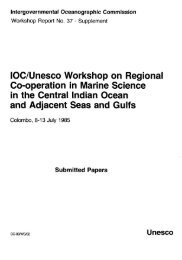Manual on sea level measurement and ... - unesdoc - Unesco
Manual on sea level measurement and ... - unesdoc - Unesco
Manual on sea level measurement and ... - unesdoc - Unesco
- No tags were found...
You also want an ePaper? Increase the reach of your titles
YUMPU automatically turns print PDFs into web optimized ePapers that Google loves.
Sea Level Measurement <strong>and</strong> Interpretati<strong>on</strong>6. Quality C<strong>on</strong>trol of DataData recovered from a tide gauge always provide timeserieswith a particular sampling interval. Even analoguecharts are digitized to provide <strong>level</strong>s at regular points intime. Until recently, most data acquired this way havebeen archived <strong>and</strong> distributed by data assembly centres(DACs) in a quality c<strong>on</strong>trolled (QC) <strong>and</strong> fully documentedform. This results in ‘delayed mode’ data sets. Volume 3<strong>and</strong> earlier editi<strong>on</strong>s of this <str<strong>on</strong>g>Manual</str<strong>on</strong>g> dwelt at length <strong>on</strong>QC of data in delayed mode. Such QC methods are wellestablished <strong>and</strong> will not be repeated here.However, <strong>sea</strong> <strong>level</strong> data are required for many purposes,<strong>and</strong> in many applicati<strong>on</strong>s there is no time to perform afull QC. For example, during the World Ocean Circulati<strong>on</strong>Experiment (WOCE), the University of Hawaii Sea-LevelCentre (UHSLC) was established as the ‘fast delivery’DAC, with the British Oceanographic Data Centre(BODC) as the ‘delayed mode’ WOCE DAC. The UHSLCwas tasked with the assembly, quality c<strong>on</strong>trol <strong>and</strong> distributi<strong>on</strong>of <strong>sea</strong> <strong>level</strong> data from WOCE gauges withinseveral weeks, comparable to the delay, at the time, inthe delivery of satellite altimeter data. Meanwhile, BODChad the task to assemble <strong>and</strong> supply <strong>sea</strong> <strong>level</strong> data fromthe WOCE network to the full extent of quality c<strong>on</strong>trolwithin 18–24 m<strong>on</strong>ths from data collecti<strong>on</strong>.More recently, there has been an emphasis <strong>on</strong> makingas many GLOSS gauges as possible deliver datain nearreal time, i.e. typically within an hour. Thisrequirement has arisen for several reas<strong>on</strong>s. First, withreal-time data, it is immediately obvious when problemswith a gauge have occurred. Sec<strong>on</strong>d, the databecome available for many other applicati<strong>on</strong>s within‘operati<strong>on</strong>al oceanography’, e.g. for flood warningor for assimilati<strong>on</strong> of <strong>sea</strong> <strong>level</strong> data into oceancirculati<strong>on</strong> models. The data are also then useful fortsunami warning systems in certain areas. The GLOSSprogramme has defined the UHSLC as the ‘GLOSSReal-Time Centre’ in additi<strong>on</strong> to the existing ‘FastCentre’ resp<strong>on</strong>sible for producing hourly values form<strong>on</strong>itoring <strong>and</strong> models.If <strong>sea</strong> <strong>level</strong> data are used in near-real-time applicati<strong>on</strong>s,then the operati<strong>on</strong>al system has to be robustenough not to be perturbed when bad data arerecorded (e.g. data spikes). One way to guard againstbad data is to have c<strong>on</strong>tinuous human oversight ofthe data stream (e.g. as occurs in the UK StormTide Forecasting Service for flood warning). Realtimequality c<strong>on</strong>trol (RTQC) software is now beingdeveloped by several groups. For example, in Europethe Spanish Ports Authority (Puertos del Estado) hasdeveloped an automatic quality c<strong>on</strong>trol of <strong>sea</strong> <strong>level</strong>data for detecti<strong>on</strong> of spikes, gaps, etc. before datais displayed <strong>on</strong> the public web-page <strong>and</strong> assimilatedinto a storm surge forecasting system. Informati<strong>on</strong>about this software <strong>and</strong> the algorithms for spikedetecti<strong>on</strong> can be obtained from Begoña Pérez.42IOC <str<strong>on</strong>g>Manual</str<strong>on</strong>g>s <strong>and</strong> Guides No 14 vol IV
















